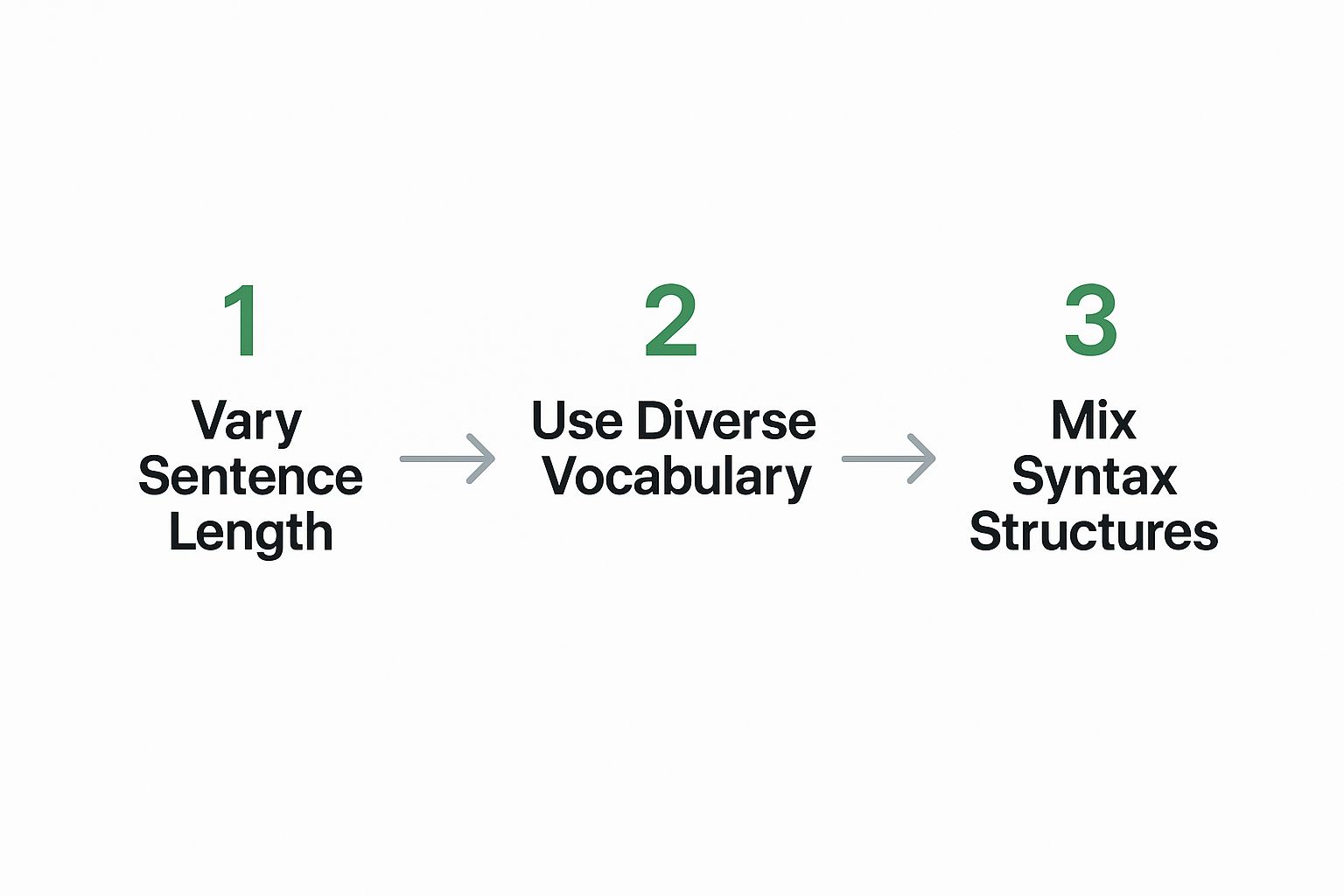
A Writer's Guide to Avoid AI Detection
July 18, 2025
Let's be real. Beating an AI detector isn't about outsmarting a machine. It's about making your content genuinely better—the kind of stuff people actually want to read.
This means you need to get your hands dirty and inject a real, human voice into the text. You have to break up the monotonous sentence patterns and swap out those predictable, robotic phrases for language that has some life to it.
Ultimately, the best way to fly under the radar is to create writing that’s authentic, interesting, and actually delivers value.
Why This Matters More Than Ever
AI detection tools are popping up everywhere, from university plagiarism checkers to SEO agencies vetting their content. But the conversation is starting to shift. It's no longer a simple game of "human vs. machine." The real mission now is to produce content that connects with an audience and meets a high standard of quality.
Straight-out-of-the-box AI text is full of tells. Both algorithms and sharp-eyed readers can spot them from a mile away. Learning to recognize these giveaways is your first step toward creating work that feels truly human.
The Dead Giveaways of AI Content
One of the most obvious red flags is that robotic, almost sterile tone. AI models often default to a voice that's way too polished and formal, completely lacking the warmth and personality you get from a human writer. It makes the content feel cold and distant.
Another huge tell is the repetitive phrasing and sentence structure. An AI might use the same transition words over and over or start every other paragraph the same way. That kind of rigid uniformity screams "machine" to a detector that's built to spot unnatural patterns.
The biggest problem with unedited AI text is how predictable it is. It lacks what experts call "burstiness"—that natural mix of short, punchy sentences and longer, more thoughtful ones that we all use when we write. Without it, the text just falls flat.
Finally, AI-generated content almost always lacks real insight or personal stories. It can pull together facts and summarize information like a champ, but it can't offer a unique perspective, share a relatable experience, or add the kind of emotional depth that makes a reader connect. Fixing these issues is the key to making your content not just undetectable, but more importantly, worth reading.
The Bigger Picture Here
Beyond just writing quality, the explosion of AI tools has created some serious security and integrity headaches, especially for big companies. For large organizations, spotting AI-related security problems is a massive challenge.
A 2025 report found that a staggering 73% of enterprises got hit with at least one security breach tied to AI, with the average cleanup cost ballooning to $4.8 million. Worse, it takes an average of 290 days just to get these AI-specific breaches under control. If you want to dig deeper, you can check out the latest breach statistics to understand the financial impact of these security risks.
This just drives the point home: producing authentic, human-vetted content isn't just about sounding good. It's about maintaining trust, security, and integrity in everything you publish.
Crafting Prompts for Human-Like AI Output

Want to know the single best way to avoid AI detection? It all starts with a better draft. The truth is, the quality of your AI-generated text is a direct reflection of the quality of your prompt.
If you feed the machine a generic, lazy instruction, you'll get a generic, lazy piece of writing that’s easy for any detector to flag. Detailed, layered instructions are your first and best line of defense.
Think of it like giving directions. A basic prompt is like telling a driver, "Go to the city." A great prompt is like saying, "Drive downtown using the side streets, avoid the highway so we can see the historic architecture, and look for a parking spot near the old courthouse." The second set of instructions gives context, constraints, and a clear goal, leading to a much more interesting journey.
Giving Your AI a Persona and Voice
One of the most powerful tricks I've learned is to assign the AI a specific persona. This immediately frames the content and steers it away from that default, robotic tone that detectors sniff out so easily. Instead of just asking for an article, you instruct the AI to embody a character.
Here’s a quick before-and-after to show you what I mean:
- Before: "Write a blog post about the benefits of remote work."
- After: "Act as a skeptical HR manager with 15 years of experience. Write a blog post that reluctantly admits the benefits of remote work but also highlights the real-world challenges with a dry, witty tone. Use short, declarative sentences mixed with longer, more complex ones."
See the difference? The "after" prompt doesn't just ask for information; it demands a personality. This forces the AI to vary its sentence structure and vocabulary in a much more human-like way, giving you a draft that needs far less editing. For more ideas on refining AI drafts, check out our complete guide to bypass AI detection.
Layering Instructions for Better Results
A single command is rarely enough. To truly get human-sounding output, you need to layer your instructions, focusing on tone, style, and structure. This kind of micro-management at the prompt stage pays off big time.
The goal is to eliminate the AI's most predictable habits before it even starts writing. By defining the rules of engagement, you guide the model toward creating content with more "burstiness"—the natural variation in sentence complexity that human writers use instinctively.
Here are a few specific instructions you can mix into any prompt to get better results:
- Define the tone precisely: Don't just say "friendly." Use descriptive words like "conversational," "academic," "inspirational," or "technical but accessible."
- Specify sentence structure: Explicitly ask for a mix of simple, compound, and complex sentences. You can even add rules like, "start no more than two consecutive sentences with the same word."
- Introduce rhetorical devices: Ask the AI to sprinkle in rhetorical questions, analogies, or even brief, hypothetical anecdotes. These make the text more engaging and less robotic.
By building these constraints into your initial command, you're essentially pre-editing the content. It’s a proactive approach that not only helps you fly under the radar of AI detection but also saves a massive amount of time, giving you a stronger, more authentic first draft to work with.
Editing is Where the Magic Happens

This is where you roll up your sleeves and get to work. A well-crafted prompt gives you a decent starting point, but the editing process is what truly separates passable AI content from genuinely human writing. To consistently avoid AI detection, you need to go way beyond a simple grammar check and start injecting your own unique voice into the text.
Think of it less like polishing and more like a complete remodel. You're not just touching up the surface; you're fundamentally reshaping the AI's first draft. That means weaving in personal stories, honest opinions, and the kind of emotional nuance that AI models just can't fake on their own. It’s all about building a real connection with your reader, something an algorithm simply can't do.
Break Up That Robotic Rhythm
One of the dead giveaways of AI writing is its perfect, monotonous sentence rhythm. The models often spit out paragraph after paragraph of sentences that are all roughly the same length and structure. To a human reader, it feels incredibly flat and unnatural. Your first editing pass should be a full-on assault on this pattern.
Hunt down those paragraphs where every sentence follows the same beat. Your mission? Create some variety.
- Combine choppy sentences: Got a few short, simple sentences in a row? Merge them into a longer, more thoughtful one to add a bit of depth.
- Split up long-winded sentences: If you find a dense, rambling sentence, break it into two or three shorter, punchier ones. This adds clarity and impact.
- Flip the structure: Don't let every sentence start the same way. If it begins with the main point, try rewriting it to lead with a secondary clause instead.
This technique is all about improving what’s known as "burstiness." Human writing is naturally uneven; we mix quick, simple thoughts with longer, more detailed explanations. Learning to mimic this rhythm is one of the most powerful things you can do. For a deeper dive, check out our guide on how to humanize AI text for better results.
Remember, the goal here is intentional imperfection. Perfectly structured prose screams "machine." It's the slightly choppy, natural flow of human writing that feels authentic and builds trust.
Swap Predictable Words for Dynamic Language
AI models pull from massive datasets, but they tend to play it safe, defaulting to a very predictable vocabulary. Words like "furthermore," "in conclusion," and the dreaded "it is important to note" are classic AI crutches. Your job is to spot this robotic language and swap it out for something more dynamic and interesting.
I recommend keeping a "hit list" of these common AI phrases. When you see them pop up in a draft, don't just find a synonym—rephrase the entire thought. This isn't about a simple thesaurus lookup; it's about choosing words that carry the right intent and emotion for what you're trying to say.
To see what I mean, let's look at some common AI patterns and how you can transform them into something that sounds like an actual person wrote it.
AI Writing Patterns vs Humanized Alternatives
| Common AI Pattern | Humanized Alternative | Why It Works |
|---|---|---|
| "In today's fast-paced world..." | "Let's be honest, things move quickly." | This ditches a tired cliché for a direct, conversational opener that immediately connects with the reader. |
| "It is crucial to understand that..." | "Here's the thing you really need to get." | It replaces formal, passive language with an active, confident voice that feels more authoritative. |
| "This technology has the potential to..." | "Imagine what you could do with this." | This shifts from a vague, impersonal statement to a direct appeal that sparks the reader's imagination. |
By hunting down and replacing these robotic footprints, you erase the most obvious signs of AI. The final touch is to sprinkle in your own personality—ask a rhetorical question, add a quick personal aside, or state a clear opinion. That's what completes the transformation from a sterile AI draft to content that is genuinely yours.
Advanced Techniques for Bypassing Detectors

If you're serious about creating content that sails past even the most sensitive detection systems, you need to understand what they're actually looking for. It’s not just about grammar or spelling anymore.
Advanced detectors analyze two core concepts that give AI writing away: perplexity and burstiness. Grasping these ideas is your key to making AI-assisted text truly undetectable.
Perplexity is just a fancy word for unpredictability. AI models are trained to pick the most logical next word, which makes their writing smooth but also highly predictable. Human writing, on the other hand, is messier. It’s less obvious.
Burstiness is all about the rhythm and flow of your sentences. We naturally mix short, punchy statements with longer, more descriptive ones. AI often produces text with a uniform sentence length, creating a monotonous, robotic rhythm that detectors can easily spot.
To successfully avoid AI detection, you have to master both.
Mastering Perplexity and Burstiness in Your Writing
Okay, the theory is one thing, but putting it into practice is what really counts. Actively editing for perplexity and burstiness means you’re not just correcting typos; you’re rewriting for authenticity. It takes a conscious effort to break the AI’s predictable patterns.
Instead of just accepting the AI’s default word choices, try introducing less common synonyms or even idioms that give the text more flavor and personality. This simple change can make the writing far less predictable.
A great way to check for burstiness is to read your text aloud. Does it sound robotic? Is the rhythm flat? If so, start restructuring your sentences immediately.
Here are a few actionable methods to try:
- Mix Sentence Types: Deliberately follow a long, winding sentence with a very short one. For example: "While the initial data suggested a clear and undeniable trend toward complete market saturation, the reality on the ground was far more complicated." Then add: "It was a mess." The contrast feels human.
- Introduce Unique Vocabulary: Don’t be afraid to use industry-specific jargon (if it fits your audience) or more nuanced vocabulary that a typical AI model might shy away from.
- Use Rhetorical Questions: Why not pose a question directly to the reader? It breaks the flow in a very human way, creating engagement and disrupting the AI’s linear, statement-based structure.
The core idea is to introduce controlled chaos. Your goal is to make the text feel less perfect and more like it was crafted by a real person with a distinct thought process, not generated by an algorithm optimizing for predictability.
For those who want to really nail this, our detailed post offers more strategies on how to pass AI detection with confidence.
Using Humanizer Tools as a Final Polish
AI humanizer tools can be a powerful asset, but only if you use them the right way. Don’t think of them as a one-click magic bullet.
Instead, view them as an intelligent editing assistant designed to spot and fix the subtle, machine-like patterns you might have missed. A good humanizer helps you enhance burstiness and perplexity without stripping away your core message.
This technology is in a constant cat-and-mouse game with detection tools. The challenge is growing, especially as AI is used for more than just writing. For instance, deepfake technology has become a major concern; in 2023, AI-driven fraud using deepfakes led to losses of over $200 million. As you can read in this piece about the rise of AI fraud on Nasdaq.com, criminals created fake personas and phishing emails, highlighting just how difficult it can be to spot sophisticated AI.
The best approach? Write and edit your draft first. Then, run it through a humanizer for a final check. This workflow ensures your unique voice and ideas remain at the center, with the tool providing that final layer of polish needed to avoid AI detection.
Putting It All Together: A Practical Workflow
Okay, so we've covered the individual tactics. But how do you bake this into a repeatable process? Having a solid workflow is the key to creating content that sounds human every single time, without starting from scratch.
Let's walk through a real-world example. We'll take a painfully generic, AI-written paragraph and transform it into something that actually connects with a reader and breezes past AI detection.
Here’s the kind of bland, robotic text we’ve all seen before:
“It is imperative for businesses to leverage social media. The digital landscape necessitates a strong online presence to engage with customers. Furthermore, companies that utilize these platforms can enhance brand visibility and drive sales.”
Classic AI. It's stiff, loaded with buzzwords, and has absolutely zero personality. It reads like a machine wrote it because, well, a machine wrote it. Now, let’s run it through our humanizing process.
The Transformation in Action
First things first, we need to inject a real voice and shatter that robotic rhythm. Instead of a stuffy phrase like "it is imperative," I'll start with something direct and relatable. I'm also going to kill predictable words like "utilize" and "leverage" and swap them for stronger, more active verbs.
Next, it’s all about creating "burstiness." I'll mix short, punchy sentences with longer, more descriptive ones to make the flow feel natural, not programmed. Tossing in a specific detail or a quick "what if" scenario also boosts its "perplexity," making it far less predictable for an algorithm to flag.
This infographic breaks down the core ideas behind this transformation.

As you can see, it really boils down to varying your sentence length, vocabulary, and structure. Those are the building blocks for making AI text feel like it was written by a person.
After applying these simple edits, here's our new and improved paragraph:
“Forget what you’ve heard—social media isn't just an option anymore. It's essential. If your customers are online, you need to be there too. Think about it: a strong presence on these platforms does more than just get your name out there. It’s how you build a community, show your brand’s personality, and ultimately, grow your business.”
See the difference? The revised version is conversational, energetic, and feels authentic.
This workflow isn't just about fooling a detector; it's about making your content genuinely better. This is especially true in high-stakes industries like finance, where trust is non-negotiable. The financial sector is already grappling with this, with over 50% of fraud now involving deepfakes and other AI tools. In fact, nine out of ten banks are now deploying their own AI to protect consumers.
If you're interested, you can discover more insights about AI fraud trends from Feedzai's report. It’s a stark reminder of why authentic, human-vetted communication has never been more critical.
Frequently Asked Questions About AI Writing
https://www.youtube.com/embed/2bOnpKC4OVM
As AI writing tools find their way into just about every workflow, a lot of good questions are coming up. It’s a new frontier, and knowing how to use these tools the right way is key.
Let's dig into some of the most common concerns I hear.
Can AI Detection Tools Be 100% Accurate?
The short answer? Absolutely not.
AI detectors aren't magic, and they can’t give you a definitive yes or no. They're built to spot patterns common in machine-generated text, like overly predictable phrasing (low "perplexity") and uniform sentence structures (low "burstiness").
This means they make mistakes. You’ll see false positives, where a person’s writing gets flagged, and false negatives, where AI text sails right through. Studies have even shown that human experts can't reliably pick out AI writing. So, think of detector scores as a helpful guide, not a final verdict. The real goal should always be to create great, valuable content that connects with people.
Is It Unethical to Use AI for Writing?
This is a big one, and the ethics really come down to your intent and transparency.
Using an AI as a partner to brainstorm ideas, build an outline, or break through a nasty case of writer's block is perfectly fine. It's really no different from using a calculator for a complex math problem or a spell-checker to catch typos. It’s just another tool in the toolbox.
The ethical line gets blurry—and crossed—when you try to pass off raw, unedited AI text as your own original work. This is especially true in school or when you're trying to fool an audience.
The key is to add significant human value. If you’re steering the ship, injecting your own experience, and giving it a thorough edit, you’re using AI as an assistant, not a ghostwriter.
Does This Guarantee I Can Avoid AI Detection?
While all the strategies we talk about here will make it much, much harder for your content to get flagged, there's no such thing as a 100% guarantee. The tech on both sides—the AI that writes and the AI that detects—is moving incredibly fast.
But here’s the thing: mastering a human-first editing process isn’t just about avoiding AI detection. It’s about creating better, more compelling content. When you focus on making your writing authentic and high-quality, you end up with something that truly connects with your readers. And that’s a goal that will always matter more than tricking an algorithm.
Ready to transform your AI drafts into polished, human-like text that resonates with your audience? Natural Write is a free tool that instantly refines robotic writing, enhances clarity, and helps you bypass AI detection with a single click. Start humanizing your content today at https://naturalwrite.com.


